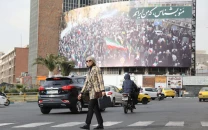Islamophobia: Aftermath
Prejudice against Muslims prevails in the US, with media bias playing a large part in shaping the perception of Islam.

Islamophobia: Aftermath
Nine years after the 9/11 attacks, the site of the former twin towers are open to a new controversy. A December 2009 front-page New York Times story broke the news of a Muslim prayer site that was born from an abandoned Burlington Coat Factory, a popular American discount clothing chain. This modest mosque, only two blocks from Ground Zero, the popular name given to the area that once was the World Trade Centre, aspired to become an Islamic centre. The New York Times breaking news story quoted Imam Feisal Abdur Rauf, the cleric behind the initiative, as saying, “We want to push back against the extremists.”
News of the proposed Islamic center went unremarked until August 2010. Peyser, who is a graduate of Columbia University’s School of Social Work and is politically active, thinks that reactions to the Islamic centre coincided with campaigning for the 2010 gubernatorial elections held in September and November. “It’s something that comes up as a wedge issue,” said Peyser while eating his veggie burger at a halal restaurant in Uptown Manhattan. “The difference is that it is one of those issues that are a little more dangerous.” A Christian Science Monitor opinion piece published in August 2010 is headlined “Ground Zero mosque as wedge issue: Muslims vs. ‘real’ Americans.
Unlike Peyser, Khadija Haseeb looks Muslim. She is Pakistani and wears a hijab. Haseeb moved to New York in late 2008 to join her husband who already lived there. In April 2010, the couple moved to Wisconsin, where she began a master’s in education at Northwestern University in Evanston, Illinois. Haseeb did not always wear a hijab. She started wearing it five months after moving to New York. “Being a hijabi in New York was not much different than being a non-hijabi,” she said. She said she experienced no discrimination except when shopping at high-end stores like Bloomingdale’s and Gucci, where she felt a marked difference between the way she was treated before and after adopting the hijab. “But wearing a hijab in Wisconsin is a whole different story,” said Haseeb. “I didn’t feel any discrimination, I just felt a lot of reluctance,” said Haseeb, “reluctance in approaching, reluctance in talking, reluctance in being friendly.” Haseeb said being a Muslim was a constant struggle and it wouldn’t have been if she didn’t wear the hijab.
“If I sit down next to someone on the subway they may or may not move, but if I pull out a Quran or something with Arabic writing on it, the minute other seats open up, they move,” said Peyser. He said he is more paranoid of people he knows than of strangers. He said statistics that say seven in ten New Yorkers don’t want the Islamic centre to be built make him paranoid. Not so much of strangers than of people who know him. “It makes me think which seven of my ten friends don’t want it but don’t say it to my face,” he said.
Along with coursework Haseeb teaches at a school in the Milwaukee area where she is the only Muslim at the school. Once, while teaching a class, they heard a noise outside. “A student gets up and asks, ‘Are we under attack? Are you guys attacking us again?’” said Haseeb adding that she didn’t know how to handle the situation. “That was the point I totally broke down.” The mentor teacher with her explained to the class that they shouldn’t blame the entire community for the actions of some.
“It’s totally ingrained in the future generations that are coming up,” said Haseeb. “At least it seems so in my teaching experience.” Haseeb said that Islamophobia in the US is “media-induced.” She mentioned the Islamic centres in the Midwest that have been causing protests at a smaller scale than the one in Lower Manhattan. The mosque in Sheboygan County, Wisconsin sparked off a similar debate. Opposition to this mosque was reported in a Time magazine article in August this year. The story quoted an unnamed resident of that area as saying, ““I know they’ll say there’s the violent or jihad Muslims and there’s the peaceful Muslims, [but] to me it doesn’t make a difference because their goal is to wipe out Christianity around the world.”
On August 25, Ahmed Sharif, a cab driver in New York City was stabbed by a passenger. Headlines in daily newspapers left no doubt that it was a hate crime perpetrated by an Islamophobe. The New York Times headline read, “Rider Asks if Cabby is Muslim, Then Stabs Him.”
Headlines in daily newspapers usually say something negative about Muslims, said Peyser. It is no wonder then that there is an uptake in hate crimes, he said. “Even the cabby news was news for like what, two days,” said Peyser. The bombing of a mosque in Florida while there were worshippers inside, even if no one was injured, did not make make the national news, said Peyser. “If that had been a synagogue or a church that Muslims blew up, imagine the kind of headlines it would have got,” said Peyser.
Published in The Express Tribune, October 17th, 2010.



















COMMENTS
Comments are moderated and generally will be posted if they are on-topic and not abusive.
For more information, please see our Comments FAQ